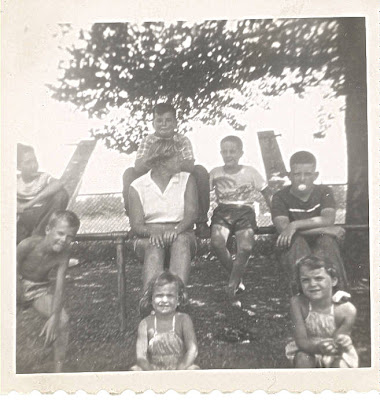During the summer there was a program, sponsored by Hamilton Township, I don’t know what the proper name for the program was, but we called it “Playground”. If someone asked what you’re were doing today, your response would be, I’m going to “Playground”, strange huh.
Ours was at Groveville School, I know there was one at Switlik Park and I am sure they were at all township schools, in the 1950's
I seem to think it started the week after school ended and stopped a week before school started. It used to start in mid morning and end in mid afternoon, five days a week. We had organized games, projects, and contests. Once a week we would have pool day, where we would be taken to Woodlawn Pool, for the day, I think it cost .25 to go and you would usually take another .25 for a soda and a snack, WOW. It was no Great Adventure, but it was to us, but then Great Adventure is 59.99 + 15.00 to park, more than Dad made in a week in 1954.
It gave us a different place to swim, instead of Cold Spring or Black Rock on the Crosswicks Creek
The person in charge was usually a High School student or college student that needed a summer job. The only person I remember doing it was a girl named Sue, she is in the pictures below, and my friend Leota Mushinski Walder reminded me that she and Carol Spence were in charge of the playground at one time, but there were others.
The kids in these photos are, Charles Donnell (with hatchet), Mike & Denny Moyer, Walt Sehorn, Emma & Ann Reynolds, Tom Dwier, Gary Lippincott (me), and Sue, the counselor.
Below are some of the activities, it must have been pool day as some of us had towels and tubes. These are some of the things we learned;
We learned how to do nothing
Left to Right; Dennis Moyer, Tom Dwier, Sue the counselor, Charlie Donnell (behind Sue), Mike Moyer, Walt Sehorn (blowing Double Bubble). Girls left to right Ann Reynolds & Emma Reynolds.
To Give Free Hatchet Haircuts

Left to Right, rear; Walt Sehorn, Sue, Dennis Moyer, Tom Dwier, Charlie Donnell, Front row, Left to Right; Emma Reynolds, Mike Moyer, & Ann Reynolds
How to Play the Harmonica - I think

Left to Right Front; Sue, Mike Moyer, Walt Sehorn,
Rear Left to Right; Dennis Moyer & Charlie Donnell
How to look tough - When your not
Left to Right; Charlie Donnell, Dennis Moyer,
Ann Reynolds, Walt Sehorn, Sue, & Mike Moyer
How to control the Kids
 Left to Right; Sue, Charlie Donnell, Mike Moyer, Walt Sehorn, & Dennis Moyer
Left to Right; Sue, Charlie Donnell, Mike Moyer, Walt Sehorn, & Dennis Moyer

Dennis Moyer & Sue
How to Control the Camp Counselor

Left to Right; Sue, Charlie Donnell, & Walt Sehorn
First Aid

Left to Right;Walt Sehorn, Charlie Donnell, Sue,
Dennis Moyer & Gary Lippincott is the patient.
How to impress the Girls

Left to Right; Emma Reynolds, Ann Reynolds, Mike Moyer &
Gary Lippincott rear pretending he has a cigarette.

























